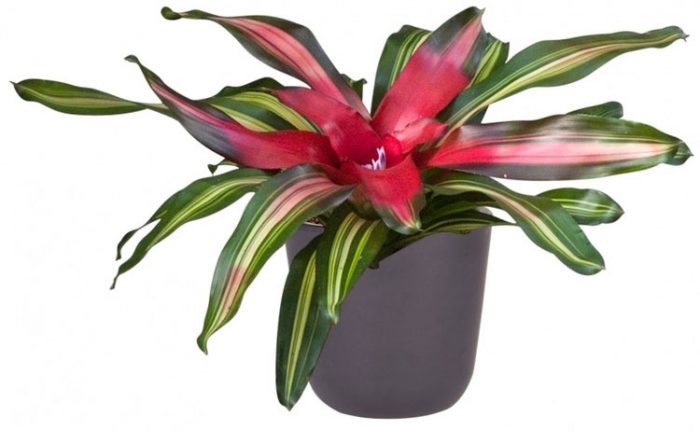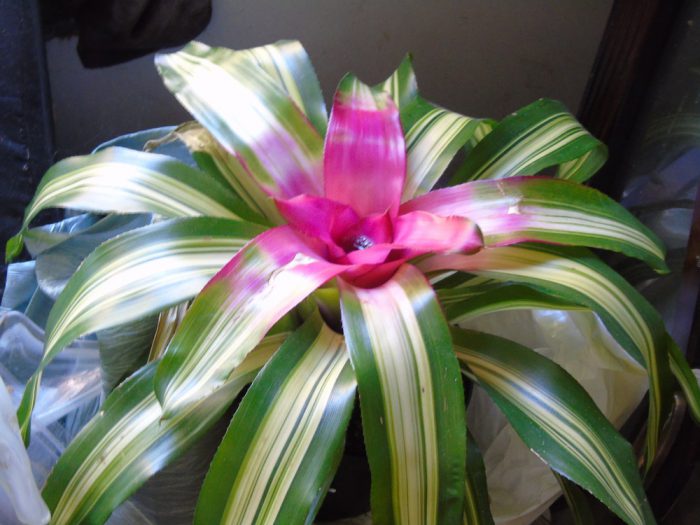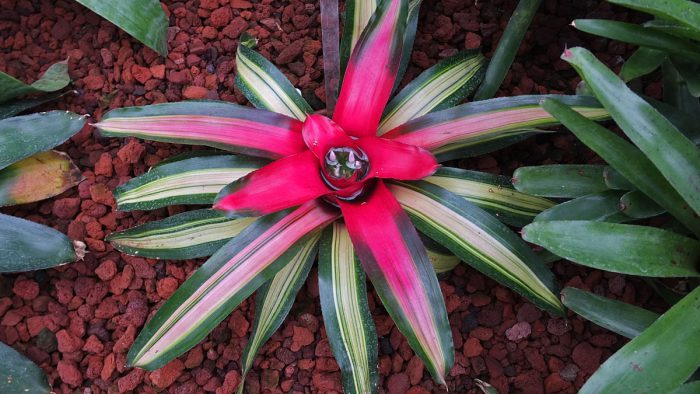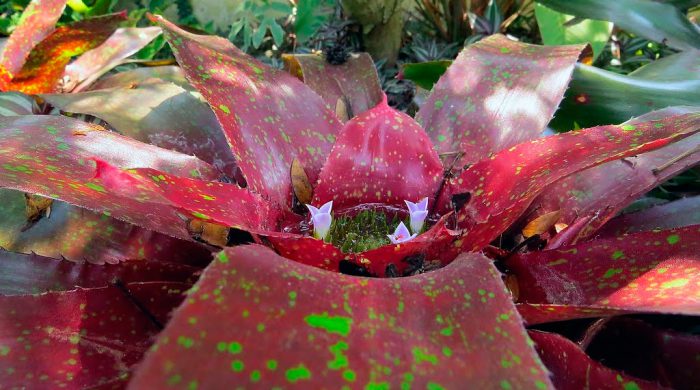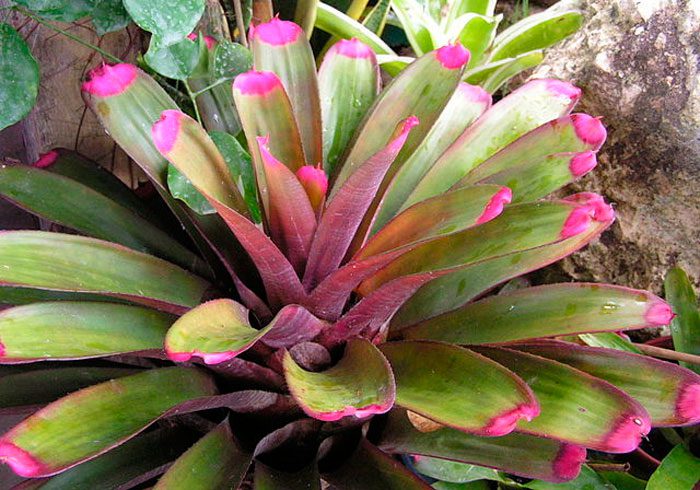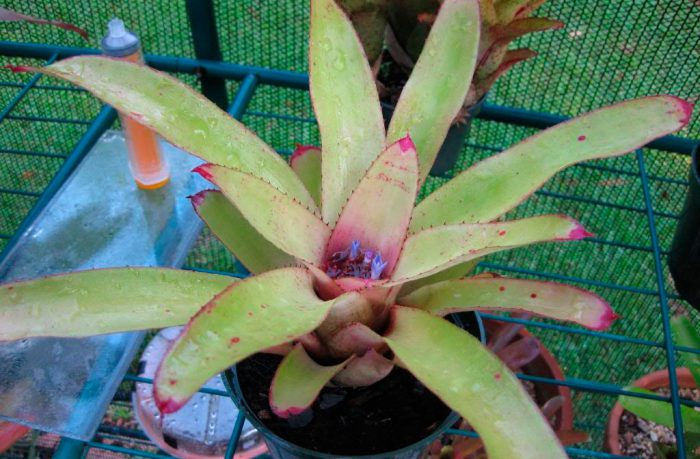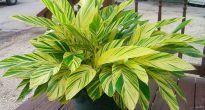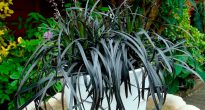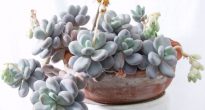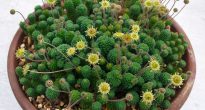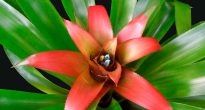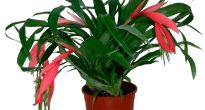Genus neoregelia (Neoregelia) includes epiphytic and terrestrial plants directly related to the bromeliad family. In nature, they prefer to grow in the tropical rainforests of Eastern Colombia, Eastern Peru, Brazil, and Ecuador (in swampy areas).
The leaves of such a herbaceous, perennial, rosette plant are belt-shaped, broad-linear, and their edges are strongly serrate, or there are many small thorns on them. The center of the rosette is very often light white or lavender.
The inner part of the leaf rosette or the tips of the leaves acquire a deep red color at the time when the inflorescence appears. It comes out of the leaf sinus and has a racemose shape. There are a lot of flowers and they are located in the axils of the bracts.
Content
- 1 Caring for neorehelia at home
- 2 Video review
- 3 Main types
- 3.1 Neoregelia carolinae
- 3.2 Neoregelia marble (Neoregelia marmorata)
- 3.3 Neoregelia gloomy (Neoregelia tristis)
- 3.4 Beautiful or elegant neoregelia (Neoregelia spectabilis)
- 3.5 Little-flowered neoregelia (Neoregelia pauciflora)
- 3.6 Neoregelia sarmentosa (Neoregelia sarmentosa)
- 3.7 Bladder neoregelia (Neoregelia ampullacea)
- 3.8 Neoregelia blue (Neoregelia cyanea)
- 3.9 Tiger neoregelia (Neoregelia tigrina)
Caring for neorehelia at home
Illumination
A bright diffused light is needed. In the summer, the plant should be shaded from the direct rays of the sun. In winter, the lighting should also be good, therefore it is recommended to supplement the flower with fluorescent lamps at this time. The room needs to be systematically ventilated, but there should be no drafts.
Temperature regime
In spring and summer, neoregelia grows well and develops at temperatures from 20 to 25 degrees. In winter, it is recommended to place the plant in a cool place (about 16 degrees), under these conditions it can bloom much longer, or rather, about six months.
Humidity
You need a high humidity of at least 60 percent. Therefore, neoregelia is recommended to be grown in greenhouses or terrariums. When kept at home, expanded clay must be poured into the pallet and a little water must be poured (make sure that the bottom of the pot does not touch the water). It is also regularly sprayed. For hygienic purposes, the leaves should be wiped with a damp cloth.
How to water
In the warm season, watering is carried out regularly in the morning, while water must be poured directly into a leaf outlet. In winter, water it moderately and pour water under the root, otherwise the plant will begin to rot. The water should be lukewarm and soft.
Top dressing
They feed in May – September 1 time in 3 or 4 weeks.To do this, use fertilizer for bromeliads, which must be dissolved in water, and then water the plant with the resulting mixture.
Transplant features
The transplant is carried out only if necessary, while the neck should not be buried in loose soil. For terrestrial species, a suitable mixture consists of humus, leafy earth, and also sand and peat, taken in a ratio of 1: 2: 0.5: 1. Epiphytic plants need a mixture that includes sphagnum moss, pine bark, humus and leafy soil, as well as peat (proportion 1: 3: 0.5: 1: 1). The drainage layer should fill the flower pot by a third.
Reproduction methods
You can propagate by seeds and daughter outlets. When flowering ends, a large number of babies are formed. You can plant a lateral process with 3 or 4 leaves. To do this, take a separate pot, which is then placed in heat (from 25 to 28 degrees). It is covered with a bag or glass. Aeration of the soil is required every day. The grown-up young plants are looked after as for adults (but they are gradually taught to such care).
Before planting, the seeds must be immersed in a weak solution of manganese potassium, and after a while dried. Sowing is carried out in crushed sphagnum moss, and the top is covered with glass. They put it in a warm place (25 degrees), every day you need to spray and ventilate. They will rise after about 2 or 3 weeks. Seedlings 2–3 months old are transplanted into separate pots using bromeliad soil. Such neoregelia will bloom for the first time at the age of 3-4 years.
Pests
Can settle mealybug, aphid, shield or spider mite.
When infested with bromeliad scabbard, pests are found on each side of the leaves, which turn yellow and fall off.
You can fight with a special solution consisting of 1 liter. water and 15–20 drops of actellik. They can spray the plant or moisten a sponge in it and wipe the foliage.
When infected with a mealybug, the leaves suffer. It leaves a sugary discharge, and then a sooty fungus forms on them. The growth of the flower slows down, the foliage turns yellow and the plant gradually dies.
As a control of such pests, you can use pure alcohol or laundry soap. Apply the substance to a rag and wipe down the entire plant. If the infection is very strong, then you can use insecticides such as: actellik, fufanon, karbofos.
The red spider mite can settle on both sides of the leaflet. He envelops the leaf with cobwebs and it turns yellow and falls off.
To destroy the pest, wipe the leaves with soapy water. You can use the drug deciss. Systematic spraying is recommended.
Having settled on the outer part of the leaves, the aphid sucks their juice. The leaves turn yellow and fall off.
To get rid of aphids, treatment with actellik solution is required (15–20 drops per liter of water).
Can get sick with fusarium, which contributes to the destruction of the lower part of the flower, leading to its death. Occurs due to excessive moisture.
A sunburn leaves light brown spots on the leaves.
Due to too dry air, the tips of the leaves dry out and become brownish.
Video review
Main types
Neoregelia carolinae
This epiphytic plant is perennial. The leaf rosette is wide-spread and has the shape of a funnel with a diameter of up to 40-50 centimeters. Shiny leaves of rich green color have a tongue-shaped shape and a pointed tip. There are many thorns along the edges.
Before the plant begins to bloom, the top of the leaf rosette takes on a deep red hue. The capitate, simple, multi-flowered inflorescence is located deep in the leaf rosette.
Oblong white-green bracts have a pointed or rounded apex. They can be naked or there are many scales on their surface.The four-centimeter flowers are painted in a light lilac color. Slightly fused greenish sepals have a rounded shape with a pointed tip.
There are varieties with longitudinal stripes that are pink, white or green in color.
Neoregelia marble (Neoregelia marmorata)
This terrestrial plant is perennial and has a wide, dense, funnel-shaped rosette. The belt-like leaves reach 60 centimeters in length, they have a pointed tip and broadly serrated edges. On their surface there are many light scales, and they themselves are green in color with reddish specks.
The capitate, simple, multi-flowered inflorescence is located deep in the leaf rosette. Linear bracts ½ part less in length than sepals and slightly pointed. The four-centimeter flowers are pinkish or white in color.
Neoregelia gloomy (Neoregelia tristis)
This epiphytic plant is also a perennial. A narrow leaf rosette, consisting of 10-12 leaves, has a funnel-shaped shape. Green lingual leaves reach 60 centimeters in length, their ends are rounded with a short sharp tip. The front side is naked, and the wrong side has wide dark stripes, covered with small light dense scales.
The inflorescence, immersed deep in the leaf rosette, is capitate and multi-flowered. Elongated, thin-film bracts are dark red in color and have rounded and slightly pointed ends. Their edges are solid, and in length they are more than half the length of the sepals. The bare sepals are asymmetrical. They have grown together at the base and reach about 2 centimeters in length. The petals of the flowers are narrow, and their tip is pointed, at the top they are painted in a bluish color. The petals are fused with the stamens.
Beautiful or elegant neoregelia (Neoregelia spectabilis)
This epiphytic plant, which is a perennial, has a rather wide rosette of leaves. The lingual leaves are bent very strongly, they reach 40 centimeters in length. Their seamy side is colored red-green with gray stripes of scales, and the front side is green, and there is a spot at the top of a deep red hue.
The capitate inflorescence is deeply embedded in the leaf rosette. Elliptical bracts with a pointed tip are almost the same length as sepals, and their apex is covered with brownish scales, which are strongly curved.
The flowers, located on the pedicels, reach 4 to 4.5 centimeters in length. Elliptical sepals, asymmetrical in shape, slightly fused at the base, have brownish-red pubescence. The blue flowers have bent tongue-shaped petals.
Little-flowered neoregelia (Neoregelia pauciflora)
This epiphyte is a perennial. It has a narrow, funnel-shaped leaf rosette. Lingual leaves have a rounded apex, the tip of which is pointed. Their finely serrated edges are covered with millimeter spines of a dark shade. There are many small scales on the surface of the leaves, and on the obverse there are sinuous whitish stripes.
The inflorescence, located on a short peduncle, has a fusiform shape and is slightly flowering. Oval thin-filmy bracts with pointed edges are shorter in length than pedicels. Narrow-lanceolate sepals with a pointed tip, asymmetrical in shape, grow together slightly at the base. They reach 2 centimeters in length. The long (about 5 centimeters) petals are white.
Neoregelia sarmentosa (Neoregelia sarmentosa)
This terrestrial plant is perennial. It has a thin and dense leaf rosette, funnel-shaped. And on the elongated stems are offspring (daughter rosettes). Lingual leaflets have a rounded apex with a pointed tip. The edges of these leaves are finely serrated, they are colored green and on the upper part they have a reddish speck.On the seamy side, the leaves are dark green, and on their surface there are small light scales in a dense layer.
This plant has a multi-flowered inflorescence. The entire, thin-film bracts have a rounded-elongated shape. They are painted in a light shade, and their top is a rich crimson color. On their surface is a layer of scales.
The flowers are located on pedicels and reach 2.2-2.9 centimeters in length. The bare, green sepals are rounded and asymmetric at the base, growing together slightly. Partially fused petals of a bluish or white shade have pointed tips.
Bladder neoregelia (Neoregelia ampullacea)
This epiphyte is perennial. Its rosette is very dense. The folded, linear leaves are colored green and have narrow red stripes and small brownish scales. Their tip is pointed, and the edges are broadly serrated.
The slightly flowered inflorescence is deeply planted in a leaf rosette. The entire, thin-film bracts have an elongated shape, and their tip is pointed. They are larger than sepals in size. Pointed narrow-lanceolate sepals are colored green, and white along the edge. They are slightly fused at the base. The petals are also slightly fused at the base, their edges are blue, and the top is pointed.
Neoregelia blue (Neoregelia cyanea)
This perennial epiphyte has a narrow, dense leaf rosette, which consists of a large number of leaflets. Leathery pointed leaves of the tongue-shaped form are broadly serrated or whole-edged. They are painted in one color, and on the seamy side there are many whitish scales.
The multi-flowered inflorescence is located deep in the leaf rosette. The dense linear bracts are obtuse and the same size as the sepals. The bare, wide-pointed sepals, slightly accrete at the base, are asymmetric. Short-grown lanceolate petals are bluish or red in color.
Tiger neoregelia (Neoregelia tigrina)
This epiphyte is a perennial and has a round dense leaf rosette. The leaves have a tongue-like shape and rounded tops with sharp tips, and short brownish spines are located at the edges. The leaves are colored green-yellow and have brownish irregular stripes, and at the base they are covered with small scales.
The multi-flowered inflorescence is simple. The thin-film spatulate bracts have pointed tips and red tops, and they are also asymmetric. Leathery, bare light green sepals are oval in shape with a pointed tip. They are fused at the base, and there are red spots on their tops. The petals at the base have grown into a tube, and they are painted in a light purple color.

